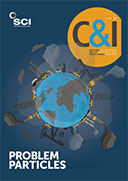The ring-like patterns left behind after removing a cup of tea or coffee from a surface are a familiar household sight. But scientists say we can now exploit this same simple ‘coffee ring effect’ to analyse what’s in our tap water – allowing us to identify multiple components quickly, easily and cheaply from a single drop of tap water in our own homes.
In physics, the ‘coffee ring’ effect occurs because droplets of particleladen liquid evaporate more quickly at the edges than at the centre, drawing the remaining liquid at the centre of the drop outwards to deposit their contents – like ground coffee grounds - at the perimeter.
A single droplet of tap water contains all manner of dissolved solids and metal ions, explained Rebecca Lahr of Michigan State University. The patterns left behind are ‘intricate and unique for each water sample,’ said Lahr, speaking at the ACS meeting in Washington in August 2017.
They may also reveal information, for example, about the hardness of softness of water, and its alkalinity. ‘The idea is to develop a faster and cheaper way to screen samples to raise red flags when there should be further analyses performed,’ Lahr said.
To test out their idea, the researchers dried droplets of various tap water samples on low-cost aluminium substrates. They then photographed the resulting coffee rings with a cell phone through an inexpensive jeweler’s loupe or eyeglass, and found reproducible residue patterns from areas across southern Michigan.
They also created synthetic tap waters of variable composition for subsequent testing. The goal ultimately, Lahr said, is to create a database or library of patterns against which to compare samples.





